Tissue Mechanics Lab
Mechanobiology Lab | Knee Kinematics & Robotics Lab| Shoulder Biomechanics Lab
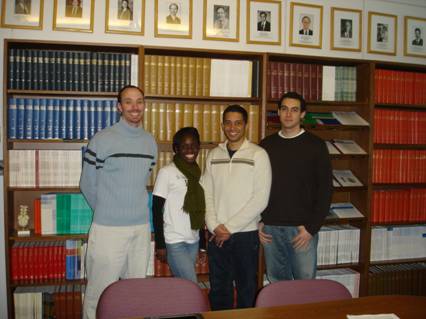
Team Members:
- Steven Abramowitch, PhD - Associate Director
- Andrew Feola
- Zegbeh Jallah
- Wenjun Zong
- Keisha Jones
- Jon Shepherd
- Suzan Steine
Research Objectives:
Apply functional tissue engineering technology to develop a better understanding of soft tissue healing, and in the process develop treatment strategies that may be applied clinically.
Research Projects:
The normal function of the vagina and supporting tissue is to bear the load of the bladder, urethra, uterus, and rectum. When this support fails prolapse can result. There are many ideas as to what could cause prolapse, but by examining all of the risk factors many studies have found that parity, giving birth or multiple births, is the largest risk factor for developing pelvic organ prolapse later in life. It is known that there are specific adaptations in the vagina and supportive tissues required to reduce the injury suffered during the passage of the fetus, and if these adaptations are not complete by the time of birth or are inept then prolapse could result. This theory has led us to where we are now in believing that prolapse can be prevented more effectively if we understand the changes that occur during pregnancy 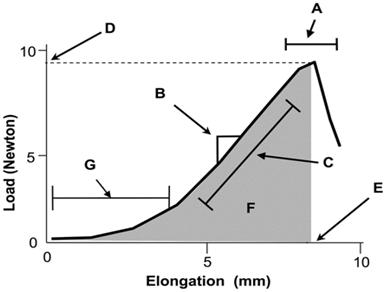 Representative load-distension curve generated from biomechanical properties testing. Similar curves can be obtained from biomechanical analysis of vaginal tissues pre and post injury. Each load to failure test results in a load-distension curve. The peak of the curve corresponds to failure of the specimen (A), which we have previously identified as disruption of level II support rapidly followed by levels I and III of the vagina. The following characteristics describe the biomechanical properties of the specimen: linear stiffness (B), slope of the curve measured in the linear region of the curve (C); ultimate load at failure (D), y-intercept of the peak of the curve; maximal distension at failure (E), x-intercept of the peak of the curve; energy absorbed to failure (F), and the area under the curve (gray area). The toe region (G) describes the initial nonlinear portion of the curve. Obstet Gynecol 2007 Pelvic organ prolapse is a problem associated with the decrease in the biomechanical properties of tissues. It has been shown to affect as many as 50% of women are over the age of 50, although only 10-20% may experience symptoms. What is even more striking is that 33% of the women having surgeries for POP may need to have the surgery repeated. The goal of our project is to characterize the biomechanical properties of the vaginal wall and its supporting structures, which could lead to findings that will help us provide early diagnosis and improved remedies for patients with pelvic organ prolapse. Thus far, we done studies evaluating the effect of hormone in menopause induced rats. The biomechanical properties of ovariectomized rats on hormones and not on hormones were evaluated. 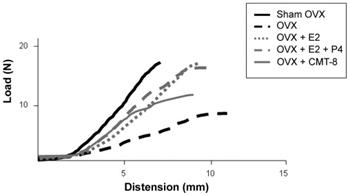 Typical curves from 4 month old virgin rats following different hormonal treatments. Typical curves from 4-month-old virgin rats following sham OVX, OVX alone, OVX followed by E2 or E2 plus P4 or the MMP inhibitor CMT-8. The peak of the curve represents the load required to induce tissue failure, and the slope of the curve represents the linear stiffness of the specimen or its ability to resist an applied load. Both of these parameters are highest in sham-operated and lowest in OVX animals. Supplementation with hormones or CMT-8 restored load and linear stiffness close to sham-operated values.Moalli. Hormones restore biomechanical properties of the vagina and supportive tissues after surgical menopause. Am J Obstet Gynecol 2008. 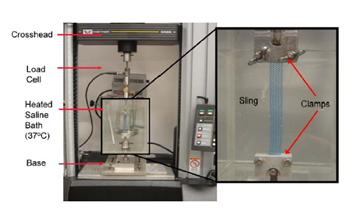 We've also done some studies evaluating the biomechanical properties of common slings used for urinary incontine and proloapse repairs. Shown below is the tensile testing setup demsonstrating a GynecareTM sample mounted to a materials testing machine. AS shown in the magnified inset, the sample is emergedin saline bath and is rigidly fixxed with customized clamps. The upper clamp is contiguous with a load cell that is connect to the crosshead . Int Journal of Gyencology 2005 Small intestine submucosa (SIS) has been shown to enhance healing in multiple applications. Current studies involve the use of SIS to improve healing of healing knee ligaments. How below is, data obtain from studies used to evaluate the healing response of MCL healing with SIS. The data shows improvement in collagen fiber diameter, with correlates to increased stiffness. Similar studies is needed for the ACL, which has a more complex healing mechanism (A)Transmission electron microscopy images (original magnification 70,000x) of collagen fibril of the MCL from A. sham-operated group, B. the nontreated group C. SIS-treated group, at 6 weeks postinjury. The arrows indicate the larger collagen fibril appearing in the SIS treated group. (B) Histogram describing the collagen fibril distributions in MCLs from the sham-operate group (n=8), nontreated group (n=4) at 6 weeks post injury. Journal of Orthopedic Research 2008 Finite element (FE) modeling has been demonstrated as a powerful tool to study the biomechanical function of biological tissues. It can provide information otherwise difficult to obtain from experiments, such as stress and strain distribution, to help to understand the mechanisms of injury, design optimal reconstruction and rehabilitation protocols, and understand the environment of ACL remodeling. However, the reliability of the model strongly depends on an appropriate geometrical reconstruction and accurate mathematical descriptions of the behavior of the tissues. Thus, the objective of this study was to build a subject-specific FE model of the ACL to analyze its stress and strain distribution under an 134 N anterior tibial load at full extension, 30° and 60° flexion, as well as under combined rotatory loads at 15° and 30° flexion. Compared to previous models, this model considered the irregular hourglass shape of ACL as well as the spiral orientation of its fiber bundles, which was incorporated into a transversely isotropic constitutive model. We hypothesize that under the anterior tibial load, when the knee joint moves to higher flexion angles, the peak stress will shift from the posterior portion of the ACL to the anterior portion of the ACL. Under the combined rotatory loads, we further hypothesize that the peak stress will be located in the posterior portion of the ACL. The resultant force predicted by the model will be validated by comparing to the experimental forces determined using the robotic/UFS testing system. 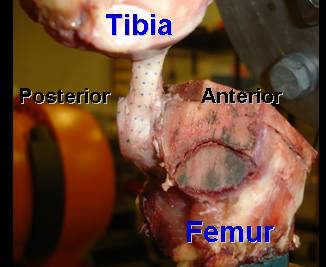 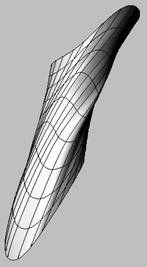 A) B) A) ACL digitization to get its geometry B) Reconstructed ACL geometry and its fiber orientation. |
Publications:
|
